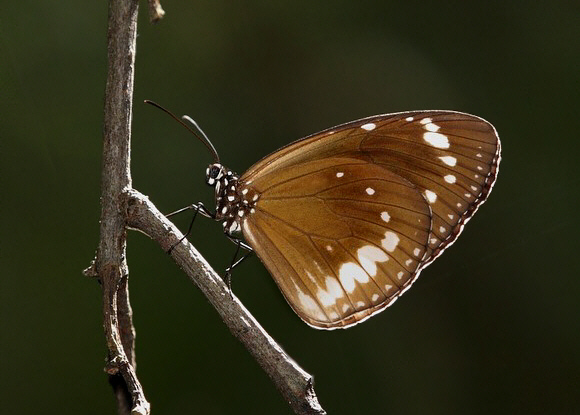
Introduction
The subfamily Danainae, which includes the Monarchs & Tigers, Nymphs and Crows, comprises of about 190 species worldwide.
The genus Euploea is very distinctive. All of the 59 known species are dark brown in colour, and most have a double band of white spots on the underside of the wings, and tiny white spots on the sides of the thorax. On the upperside, males of many species have a deep blue or purple sheen.
Euploea tulliolus is found in Myanmar, Thailand, West Malaysia, Sumatra, Borneo, the Philippines, Sulawesi, Java, West Irian, Papua New Guinea, Fiji, New Caledonia, Bougainville, eastern Australia and the Solomon Islands.
Habitats
This species can be found in a wide variety of lowland habitats including mangrove swamp, tropical rainforest, dry woodland, Acacia scrub and beach hinterlands at elevations from sea level to about 800m.
Lifecycle
The egg is white and is laid singly on shoots and tendrils of the larval foodplants. In Australia the larva usually feeds on Trophis ( Moraceae ) but elsewhere it reportedly uses Ficus ( Moraceae ) and Nerium ( Apocynaceae ). These plants have chemical defences so the larva bites partly through the leaf pedicle to cut off the flow of toxins from within the stem. The fully grown larva has 2 pairs of long black filaments on the thorax and another pair on the anal segment. Each body segment is narrowly ringed in black and white, the latter merging to orange just above the spiracles. The pupa is a remarkable object. It is metallic chrome silver in colour, and is suspended by the cremaster from beneath a leaf of the foodplant.
Adult behaviour
Males are often seen imbibing moisture from damp ground or feeding at decomposing fruit on the forest floor. Females are more often seen when nectaring, and have a strong preference for the flowers of Lantana. At dusk the butterflies gather together in communal roosts – typically of a dozen or so will cluster together, hanging from twigs in semi-shaded situations.
